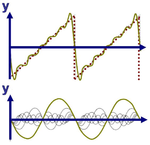Fourier series
In mathematics, the Fourier series, named after Joseph Fourier (1768—1830), refers to an infinite series representation of a periodic function ƒ of a real variable ξ, of period P:
In the case of a complex-valued function ƒ(ξ), Fourier's theorem states that an infinite series, known as a Fourier series, is equivalent (in some sense) to such a function:
where the coefficients {cn} are defined by
In what sense it may be said that this series converges to ƒ(ξ) is a complicated question.[1][2]
However, physicists being less delicate than mathematicians in these matters, simply write
and usually do not worry too much about the conditions to be imposed on the arbitrary function ƒ(ξ) of period P in order that this expansion converge to the function.
Gibbs phenomenon
A particular topic in considering how well a Fourier series approximates a function is the behavior known as Gibbs phenomenon, which refers to the behavior of the Fourier series in representing a piecewise continuous function. A summation of a finite number of terms of the Fourier series oscillates about the the target function, as shown in the figure. Adding more terms to the sum reduces this oscillation, except for functions with step discontinuities. For such functions, adding more terms reduces the oscillation, except very near the discontinuity, where adding more terms results in narrowing the width of these oscillations, but not in a reduction of their amplitude. This behavior is the Gibbs phenomenon.[3]
Real-valued functions in time and space
Fourier's theorem states that any real-valued periodic function can be expressed as a sum of sinusoidal functions with periods related to P:[4]
a series of cosines with various phases {φn}. Using the cosine relation:
and the orthogonality relations:
one finds:[5]
thereby determining the coefficients {an} and the phases {φn}.
Thus, a function periodic in time with period T can be expressed as a Fourier series:[6]
where ω0 = 2π/T is called the fundamental frequency and its multiples 2ω0, 3ω0,... are called harmonic frequencies and the cosine terms are called harmonics of ƒ. A function ƒ(x) of spatial period λ, can be synthesized as a sum of harmonic functions whose wavelengths are integral sub-multiples of λ (i.e. λ, λ/2, λ/3, etc.):[4]
If the function is a fixed waveform propagating in time, we may take ξ as:
where x is a position in space, v is the speed of propagation and t is the time. The period in space at a fixed instant in time is called the wavelength λ=P, and the period in time at a fixed position in space is called the period T=λ/v.
References
- ↑ G. H. Hardy, Werner Rogosinski (1999). “Chapter IV: Convergence of Fourier series”, Fourier Series, Reprint of Cambridge University Press 1956 ed. Courier Dover Publications, pp. 37 ff. ISBN 0486406814.
- ↑ For an historical account, see Hans Niels Jahnke (2003). “§6.5 Convergence of Fourier series”, A History of Analysis. American Mathematical Society, pp. 178 ff. ISBN 0821826239.
- ↑ A good illustration is found in Igor Florinsky (2011). “Figure 5.8: Approximation of a square wave”, Digital Terrain Analysis in Soil Science and Geology. Academic Press, p. 88. ISBN 0123850371. A treatise on the subject is: Abdul J. Jerri (1998). The Gibbs Phenomenon in Fourier Analysis, Splines and Wavelet Approximations. Springer. ISBN 0792351096.
- ↑ 4.0 4.1 Eugene Hecht (1975). Schaum's Outline of Theory and Problems of Optics. McGraw-Hill Professional. ISBN 0070277303.
- ↑ For example, see A. Anand Kumar (2011). Signals and Systems. PHI Learning Pvt. Ltd., p. 166. ISBN 8120343107.
- ↑ A.V.Bakshi U.A.Bakshi (2008). Circuit Analysis. Technical Publications, p. 10.3. ISBN 8184310579.















